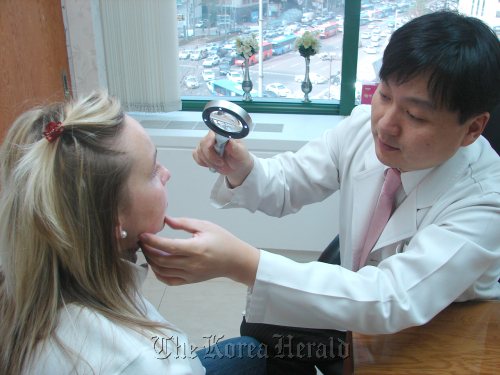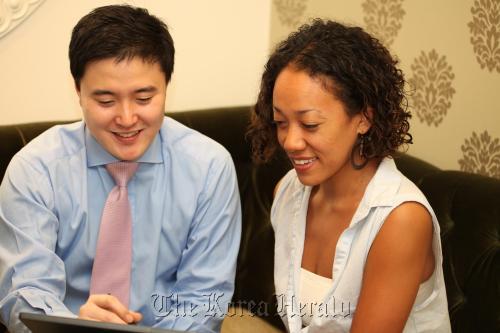
Last week, the Korea Tourism Organization signed an MOU with the largest Arabic entertainment company, the Rotana Media Group.
The agreement was the first step in promoting Korea’s fledgling medical tourism industry in a region that has traditionally turned to Lebenon for outside medical services.
On the day of the signing, mutual pleasantries were exchanged between president of the pan-Arab media conglomerate Nezar Nagro and KTO chief Lee Cham.
What was evident was that the agreement would mostly be localized to one particular sector of the nation’s medical tourism industry cosmetic surgery.
Using the Rotana Group’s far-reaching network, the deal included an agreement to feature television segments and advertising on its channels promoting Korea’s medical tourism industry across oil-rich Middle Eastern countries, part of the Gulf Cooperation Council, such as Kuwait, Bahrain, Saudi Arabia, Qatar, the UAE and Oman.
The Saudi Arabia-based group is a media powerhouse made up of a coalition of outlets engaged in film production, magazine publication, television and radio. It will showcase the Korean cosmetic service industry to millions of viewers in the region through one popular program the pan-Arab talent variety show “Star Academy.”
The cast of the American Idol-esque show is to be invited to Korea to film, while experiencing first-hand what’s available to them and to the show’s viewers.
During the MOU signing, the country’s tourism authority emphased cosmetic surgery as its flagship medical draw to boost the medical tourism industry.
After the signing at KTO headquarters in central Seoul, Nagro was asked whether plastic surgery has become more popular with people from the historically conservative Middle East.
“Yes, times are changing fast and the young people in the Middle East are becoming more conscious about their physical appearance and more aware of the world around them,” he said.
Korea’s growth engine
The current Korean administration, too, is becoming aware.
Since being selected as one of 17 new growth engines, the government has been aggressive in its mission to back medical tourism, hoping to raise its international profile and attract a flood of global clientele.
In light of such huge support, the cosmetic industry has become the main selling point.
In last year’s KTO medical tourism survey, more than 27 percent of overseas visitors sought out Korea to get some sort of cosmetic work done.
“Medical tourists from China and Japan come to Korea because technique in cosmetic treatments here are well respected in the continent,” the director of the KTO’s medical tourism center, Jin Soo-nam, said. “But now the GCC region is an emerging market we also want to attract.”
The KTO hopes to draw as many as 10,000 medical tourists annually by 2013.
Nagro, too, thinks Korea has the potential to become a hot spot for medical tourists from the Middle East.
This country could emerge as one of the most popular destinations for medical tourism,” he said.

Conversations with a sculptor
Dr. Joo Kwon’s plastic surgery center in the posh Apgujeong district of southern Seoul looks more like a postmodernist art gallery with an interior inspired by films like “2001: A Space Odyssey.”
Consultation rooms are furnished with couches draped in velvet and Baroque paintings hanging on the walls. Such decor, the center’s customer satisfaction manager said, “gives patients a sense of calm.”
It was the first officially designated international medical service institution for foreign patients by the Ministry of Health and Welfare.
Since its establishment in 1998, Joo’s practice has carried out more than 30,000 facial bone contour operations without any reported charges of malpractice.
He has, in his own words, committed himself to perfecting the craft of cosmetic surgery to give “confidence and a sense of pride” to patients.
As one of the most sought after plastic surgeons in the country, he has also dedicated himself to pro bono work, operating on children with inherited facial deformities through his “New Face, New Dream” program where his center with the cooperation of the Ministry of Health and Welfare selects a candidate after a screening process each month.
Currently, his medical center houses a staff of six plastic surgeons that specialize in different fields handling everything including facial countouring, breast augmentation, body contouring, eyelids, rhinoplasty, hair-transplantation and minimal invasive procedures that do not require patients to go under the knife.
Joo believes plastic surgery techniques and technologies in Korea some of the most advanced in the world.
“The reason why Korea is so advanced in cosmetic surgery is because Korea is a battlefield for cosmetic surgeons there’s just so many of us,” he joked.
“As expectations from patients have gone up, so has its advancement. So much so that the field now cannot be compared with or matched by other countries. Our expertise in plastic surgery has made huge leaps forward without us even knowing.”
Last week, 30 Beijing-based plastic surgeons were invited to observe a surgical procedure conducted by Dr. Joo. And even on the day of the interview, another group of surgeons from China had been observing yet another procedure.
Top-quality surgeons
Joo says it was a testament to the recognition of the advanced level of plastic surgery in Korea.
“These specialists in the field of cosmetic surgery from Beijing are highly sought after and highly qualified in China,” he said.
“But during their visit, they’ve been very keen on learning about new techniques and applying the latest in medical equipment our surgeons use.”
He said that over a decade ago when plastic surgery in Korea only meant eyelid and nose operations, overseas medical tourists came, because it was still a cheaper alternative.
“These days, one person gets several operations at once, like eyes, nose, facial contours and jaw-line reduction surgery,” he said.
“They do it as a package and because they want various work done at once. Surgeons specializing in one area are able to adjust according to how the doctor is going to mold the client’s face.”
In order to have every one of his staff on the same page, he and his crew of surgeons hold pre-op meetings discussing the direction of an operation before their patient goes under the knife.
“Discussion and mutual understanding among the doctors is an important aspect of advanced contemporary cosmetic surgery. It is a necessity,” he said.
“There was a time when plastic surgeons did none of that and just dove right in, causing dissatisfaction among many patients.”
So what makes someone beautiful?
Dr. Joo doesn’t see it so simplistically.
“There is no right or wrong in beauty. There is no textbook definition of what beauty is,” he said.
“Whatever the patient’s expectations for their surgery is, that becomes the barometer and that becomes our definition of beauty. It isn’t something doctors decide on our own. It’s always what the patient wants that matters most.”
Although his foreign clientele only makes up 2 percent of his total patient rolodex, considering the center only began accepting overseas patients last year, he feels more inbound medical tourists come to Korea.
“Compared to the previous year, we saw a five-fold increase in foreign clientele,” he said.
“Considering we only just started opening our services to overseas patients, we’ve been making strides at a fast pace. Our projection and our goal are to increase that figure so half of our clientele in the future is foreign.”
On whether patient’s from different countries request specific procedures on physical traits according to ethnicity, Joo said “Beauty is another universal language. Pursuing beauty is something everyone strives for and in what direction they seek that beauty does indeed differ from one individual to the next.
“As a specialist in facial bone contouring, I have noticed many Korean and Chinese patients carry complexes about their square jaw-line and wide facial structure.”
“With Japanese patients, they are more concerned with protruding jaw lines and an almost inverted chin, so each ethnicity does have its own preferences.”
But what about patients who aren’t East Asian?
“Patients from the Middle East also have strong contour lines around their facial structure, but I have not seen them express disappointment with how they look,” he said.
“Their standards of beauty differ from us or those in East Asia, I suppose.”
The steady swell in the number of medical tourists turning to Korea for cosmetic surgery has been buoyed by another factor.
Shopping extra gain
According to the Director of the KTO’s medical tourism center, Jin Soo-nam, shopping is an added incentive for medical tourists.
“When they’re recovering from surgery, the most popular activity for them is to go shopping,” he said.
Sure enough, a 2009 report from the tourism organization shows shopping to be the preferred choice of activity for visitors.
“I’ve seen some women spend more money on shopping than their actual operation,” Joo said in support of the survey results.
The primary reason Joo feels patients from East Asian countries like China and Japan flock to Korea for cosmetic surgery is simply because of science and anatomy.
“When I was in the states as a medical exchange student, I noticed the way American surgeons made incisions and closed incisions and they were drastically different from how I was taught in Korea,” he said.
“Here, I was taught that minimizing scarring was an important aspect of cosmetic surgery, so when I saw American surgeons making incisions on areas clearly visible to the eye I just couldn’t understand it. On top of that, when they closed incisions they just sutured them with a medical staple.
“Then I realized Caucasian skin is less prone to skin pigmentation discoloration than East Asian skin.”
As with all things, there are always critics. Critics say promoting plastic surgery would give the impression that Korea is a superficial nation that is obsessed with physical beauty.
However, there are also those who feel plastic surgery can have a positive impact on people’s lives.
“People who have deep-seated complexes and are unhappy with certain aspects of their body or face are more likely to gain confidence and become happy through cosmetic surgery,” said Han Sung-hee, the director of the YIHAN Mind Clinic in Seoul.
“But with that said, in the case of operations which dramatically alter the face, there is a chance that they might pose psychiatric problems afterwards, especially if the patient feels dissatisfied with the result of the operation or even too satisfied where traces of the patient’s former self have vanished all together.”
By Song Woong-ki (kws@heraldcorp.com)









![[Today’s K-pop] BTS pop-up event to come to Seoul](http://res.heraldm.com/phpwas/restmb_idxmake.php?idx=644&simg=/content/image/2024/04/17/20240417050734_0.jpg&u=)

![[Graphic News] More Koreans say they plan long-distance trips this year](http://res.heraldm.com/phpwas/restmb_idxmake.php?idx=644&simg=/content/image/2024/04/17/20240417050828_0.gif&u=)





![[KH Explains] Hyundai's full hybrid edge to pay off amid slow transition to pure EVs](http://res.heraldm.com/phpwas/restmb_idxmake.php?idx=652&simg=/content/image/2024/04/18/20240418050645_0.jpg&u=20240419100350)

